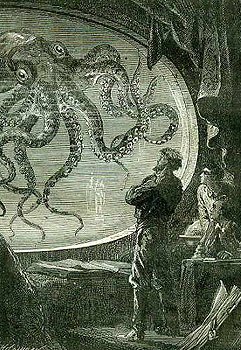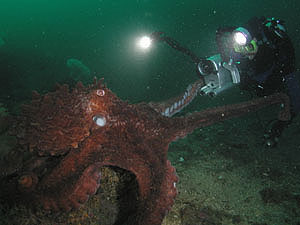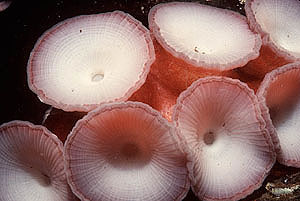
Captain Nemo watching a giant octopus through
Nautilus' bull eye. From: Jules Verne "20000 lea-
gues under the seas". Picture: A. Fehrmann.
 Captain Nemo watching a giant octopus through Nautilus' bull eye. From: Jules Verne "20000 lea- gues under the seas". Picture: A. Fehrmann. |
In 1870 the French novelist Jules Verne publishes his novel "20000 leagues under the sea" ("Vingt milles lieues sous les mers"). He tells the tale of the Captain Nemo, who - being an Indian rajah - lost all his family during the English occupation of India. Together with friends he builds the submarine "Nautilus" with which far off civilization he fights a war against suppression and injustice.
The name "Nautilus" of this submarine was taken from a cephalopod, that uses its shell like a submarine uses its diving tanks. The Nautilus can increase and decrease its depth in the sea by changing the gas pressure in its shell's chambers. its the same way modern submarines work, that were not yet known, when Jules Verne wrote his book. US navy's first nuclear submarine also was named Nautilus, after its famous fictional predecessor.
The illustration displayed above shows more connections between Jules Verne's novel and the cephalopod group. During its voyages the Nautilus gets into contact with several giant octopuses that attack the boat and have to be fought by the crew. Jules Verne not only tells of how the crew manages in desperate battles to defend the boat against the monsters, but in the preface to the battle (chapter 18) several crewmembers talk about the legend of the giant octopus. Jules Verne describes, that Olaus Magnus had written about a cephalopod one mile in length. Olaus Magnus in the 17th century was archbishop of Uppsala in Sweden and collected lots of stories from the Nordic fishermen. He writes about a monstrous fish, whose square head has got horns as long as tree roots, whose eye was glassy and cruel, a cubit in diameter and deep red in colour. It seems probable, that, if he did not see one himself, Olaus Magnus at least spoke to fishermen who had seen a giant octopus. The report contains description of the octopus's overall size of ten cubits and a tentacle length of another ten cubits. Estimating a cubit being approximately 2 to 3 feet, the Olaus octopus must have measured about 40 to 60 feet.
 Giant Pacific octopus with diver. Picture: kelpdiver.com. |
Though this octopus is quite large, it does not reach Olaus Magnus' octopus's size. Similar reports were given slightly later from another Scandinavian clergyman, the Norwegian bishop Pontoppidan. In his natural history of Norway he reports the "kraken", which is found by fishermen in about 450 feet depth. When the kraken lifts its body out of the sea it is 2.5 miles in diameter. That would mean a body length of about 2100 feet! Until today there have not been any signs, that an animal of that size ever inhabited earth. It looks like Pontoppidan and those who told him showed a certain creativity here.
 Suckers of a giant Pacific octopus. Picture: Jim Cosgrove. |
The legend of the giant octopus in fact is much older. While in Germanic languages, (as the German original of this page) the word
"Kraken" for octopus comes from the Norwegian, the word "octopus" is Greek,
meaning eight-foot, the the legends of the octopus can be retraced until Ancient Greece several thousand years ago.
Probably the most famous story about an octopus may be that of the Scylla in
Homer's Odyssey, written about 650 BC. When Ulysses during his literal odyssey passes the Messina strait,
Scylla costs him twelve of his companions. Scylla is described as of horrible appearance, with twelve feet and six heads. For the time of her life she lived with her back in a rock and with her long arms grabbed for everything edible in her reach, so also seamen on passing ships. Even today the expression "between
Scylla and Charybdis" means to have to choose between two evils. Setting aside some creativity by
Homer, it is obvious, that Scylla was nothing but a very large octopus. Those as well live with their backs in rock caverns and grab for everything edible in their reach. The many heads armed with teeth could be a hint for the octopus's suckers, though only
squids have suckers with teeth.
Far away from wanting to destroy legends and to retrace everything to a natural explanation, this might be one possibility to explain a monster from an ancient legend. But then
Homer, coming from a coast-living civilization, knew octopuses very well.
Since then the octopus has been the star in many monster stories...